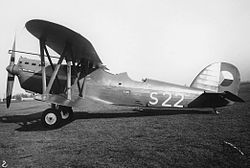Aero A.100
| Aero A.100 | |
|---|---|
 Aero A-100 |
|
| Type: | |
| Design country: | |
| Manufacturer: | |
| First flight: |
May 4, 1933 |
| Number of pieces: |
44 |
The Aero A.100 was a two-seat biplane - Aircraft of the Czech company Aero Továrna letadel Dr. Kabes , which was used as a long-range reconnaissance aircraft and light bomber .
history
The machine was developed as a further development of the Aero A.430 prototype , a variant of the Aero A.30 . The prototype A.100.1 flew for the first time on May 4, 1933 and was presented to the public on September 10 during a flight day in Prague-Kbely.
On October 18, 1933, based on the assessment of the A.100.1 by an examination commission, the Czech Ministry of Defense decided to place a production order for 11 aircraft. Another order for 33 machines for the armed forces followed on April 26, 1934. The A.100 was used in the 66th Squadron (1st Air Regiment) in Milovice , the 63rd Squadron (2nd Air Regiment) in Olomouc and Přerov, the 64th Squadron (3rd Air Regiment) in Vajnory and the 71st and 71st 72nd Squadron (6th Air Regiment) in Prague. In the latter regiment, however, they were only in service for two years, after which they were handed over to the 1st and 2nd Air Regiment and replaced by A.101 and Ab.101.
Externally, the A.100 was closely based on the A.30 and, in addition to the engine (identical to the A.430), differed from it mainly through the main landing gear with oil-damped struts.
variants
Aero A.101
The A.101 was the larger bomber variant of the A.100, equipped with a 589 kW (800 PS) three-row 18-cylinder W engine Isotta Fraschini Asso 1000, built under license by Praga . In addition, the rear cockpit was made more spacious in order to give the observer / bombardier more freedom of movement. Due to the higher payload, the A.101 had overall poorer flight performance than the A.100 despite the greater engine power. 29 machines of this type were produced.
Aero Ab.101
This type appeared from 1936, built as a bomber and reconnaissance aircraft. In the end, the machine turned out to be too weak, as it was larger than the A.101 and, with the 559 kW (750 PS) Hispano-Suiza 12 Ydrs-V engine - also a license replica from Praga - was hopelessly underpowered. The 64 units put into service with the Czech Air Force were soon exchanged for more powerful machines.
Aero A.104
The A.104 was more or less an Ab.101 with a closed cockpit. Due to the equally poor performance data as that of the Ab.101, this type was not built in series; only two prototypes were made in 1937.
Use in Spain
In 1937 the Spanish Republican government acquired 42 aircraft of the type from the Czechs. They were shipped to Spain in two deliveries. While the first actually arrived at the client with 20 aircraft, the Hordena ship with the remaining 22 aircraft was brought up by the Spanish national cruiser Almirante Juan Cervera . The aircraft type was used by both sides, whereby the question remains whether both deliveries were only A.101 (which would not be possible with the above-mentioned number of only 29 aircraft built), or whether Ab. 101 were there. The picture of a Spanish national machine shown here clearly shows an A.101 with the Italian engine. The republican side equipped two squadrons of Group No. 71 with their aircraft, which mainly flew ground support. The Franco Air Force also set up two squadrons with the Eros, which were deployed in a similar way to the aircraft on the opposite side. They were designated on the Republican side with the letters LL, on the national Spanish side with the type number 17. On both sides the aircraft were called either Praga or Oca. Most were lost in the course of the fighting. At the end of the civil war there were only four A.101s left on the winning side, three of them in Granada and one in Seville. All appear to have been retired in the late 1940s.
Military users
-
 Czechoslovakia
Czechoslovakia
-
 German Empire (only some machines)
German Empire (only some machines) -
 Slovakia 1939-1945
Slovakia 1939-1945
Technical specifications
| Aero A.100 | |
| Parameter | Data |
|---|---|
| length | 11.08 m |
| height | 3.60 m |
| Wingspan | 14.70 m above, 12.75 m below |
| Wing area | 44.30 m² |
| drive | a V12 engine Avia Vr-36 with 485 kW (650 PS) |
| Top speed | 260 km / h |
| Cruising speed | 230 km / h |
| Service ceiling | 6500 m |
| Range | Max. 880 km |
| Flight duration | 4 h |
| Empty mass | 2040 kg |
| Max. Takeoff mass | 3192 kg |
| crew | 2 men (a pilot and an observer / bombardier) |
| Armament | two rigid 7.92 mm Vickers machine guns vz.28 at the front, one Lewis double machine gun vz.30 in the Šu-31 ring mount at the rear 600 kg bomb load |
See also
literature
- AERO - compilation of aviation. Volume 2
- Hans-Joachim Mau: Czechoslovak aircraft. From 1918 until today. Transpress, Berlin 1987, ISBN 3-344-00121-3 .
Web links
Individual evidence
- ↑ Ketley, Rolfe, 1996, p. 11.
